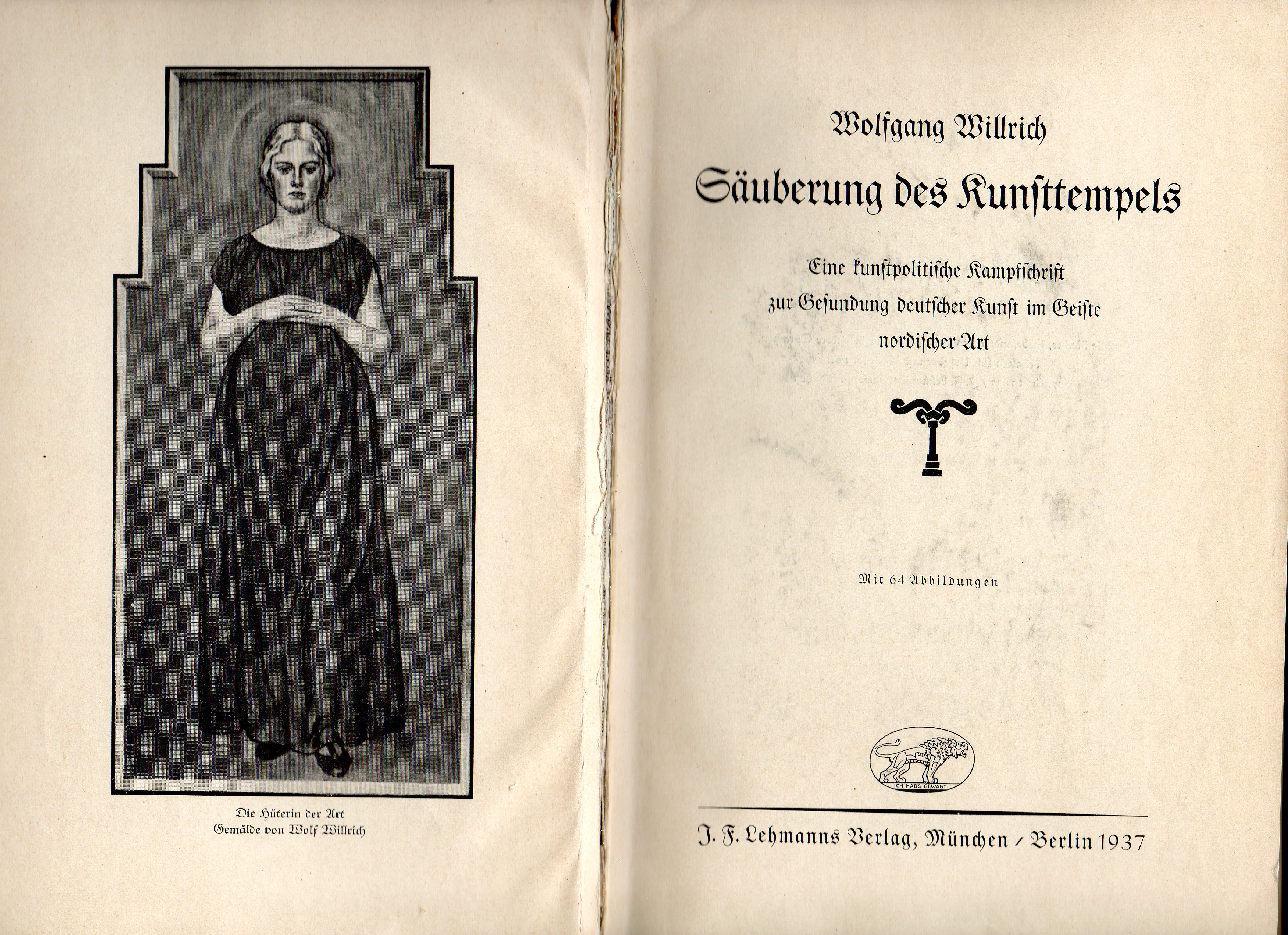1
Start at the back of the book, with the appendix. It’s six pages long, and it begins this way.
 “Appendix: some lists and references
“Appendix: some lists and references
“Proof of Jewishness is found in the following sources:
. . .
“Collaborators with the ‘Storm’ group,
led by the Jew Herwarth Walden:”
. . .
Click to enlarge.
The book, Säuberung des Kunsttempels, is by a German artist named Wolfgang Willrich, and literary history remembers it for its attack on Gottfried Benn as the author of poems unworthy of a Nazi. I knew it only by that reputation when I mentioned it in my April 22 post “The poetics of cleansing,” http://theartpart.jonathanmorse.net/?p=82, where I translated its title as Cleansing the Temple of Art. Now that I have the book in front of me, however, I see that I should have relied for my vocabulary on the newspaper, not the dictionary. I shouldn’t have written “cleansing,” which (in contemporary American usage) is ladylike, euphemistic, and semi-literary. I should have gone directly to the language of men in leather boots and written “purging.” The phrase requires such a word from the nineteenth-century nomenclature of shit. It proposes that there be a purge to rid society of certain unhealthful men and women. Listing them, name by name, it proposes that Jews are shit and non-representational artists are shit.
2
The book was published in 1937 by the house of J. F. Lehmann. In the years when the international language of science was German, Lehmann was perhaps the world’s greatest medical publisher, and after it became a political publisher as well during the Third Reich it continued to publish works of Nazi science. It was the publisher, for instance, of Hans F. K. Günther’s Racial Typology of the German People, one of the most important texts in National Socialism’s educational curriculum.
Here at the back of Säuberung des Kunsttempels the book is advertised in both a long and a short edition, along with a companion Racial Typology of the Jewish People (“Blond hair and blue eyes among Jews; gestures and behavior; odor; crime”). The page is headed, “Every German must inform himself of the questions and responsibilities of racial thought,” and at its foot it completes its catalog of Günther titles with a picture book: German Heads Belonging to the Nordic Race.

“A splendid collection of truly Nordic women and men,” explains the text. After the temple of art has been purged, to see a face there in the temple will be to take it to ourselves. The visions we place in the penetralia of memory will be fully blond, and all head. Later, when we contemplate our collection, the word Geist might come into play. We might even believe it could be perceptible in the collection’s interior, a dark blur ensouled, form by single form, just behind the bright collective hair.
3
But no; the art of Wolfgang Willrich and J. F. Lehmann is community property. It is Leviathan: an art that forms one body.


“To artists we cry, ‘Create the exemplary!’ and to other racial comrades we cry, ‘Demand exemplary forms in which a fundamentally healthy and racially noble life and a noble, undivided mind are revealed! Turn away from the worthless doll figures and saccharine nonentity of the era before the war, and turn away before all else from the ghosts and gnomes in whose sickly and foul doctrine can be seen a great evil! Be certain: what you demand of an art whose creators hearten you by deed and command, art will give you. Be certain: its images will make you obedient and disciplined German people, your better selves pledged only to what is elevated, for the sake of your children’s children!’
. . .
“Then — a servant first of the church, after that of princes, after that of cosmopolitans and philistines, latterly of the most questionable pseudo-society — German art will at last serve the German people and its highest hope: the immortality of the noble German blood!”
4
August 7, 1942. Rauca, accompanied by Garfunkel, toured the institutions of the Ghetto. During the tour he noticed a pregnant woman, in her seventh month. Rauca said: “This embryo must perish. If not, it will be taken away from its mother right after birth.”
— Avraham Tory, Surviving the Holocaust: The Kovno Ghetto Diary, ed. Martin Gilbert, trans. Jerzy Michalowicz (Cambridge, MA: Harvard University Press, 1990), 123
5
The title of Willrich’s own painting can be translated, “The Guardian of Kind.”

It shows us body within body, body all the way to the center. The blank face and averted eyes communicate only with an opaque interior. When this embryo comes forth, its hair will be blond and it will speak in imperatives and (because it will be a kind, not a man or a woman) immutable Euclidean truths. In its book now, however, it has been delayed at an imperfect stage. Its paper matrix is brown, the spine of the cloth and cardboard that shield the matrix has been snapped, and the routing slip on my interlibrary copy from the University of Nebraska is annotated, “Please HANDLE WITH CARE.” That imperative, at least, I can obey. But what may I do if or when the event promised by the image goes to completion?





